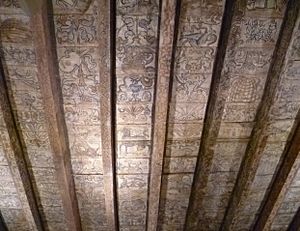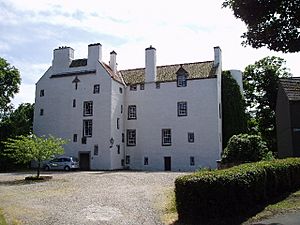Rossend Castle facts for kids

Rossend Castle is an old and important building located in Burntisland, a town on the south coast of Fife, Scotland. This castle has a long and exciting history, with parts of it dating back many centuries.
Contents
The Story of Rossend Castle
How Old Is Rossend Castle?
Rossend Castle has been around for a very long time! The first part of the castle, a strong tower called the Tower of Kingorne Wester, was built way back in 1119. Over time, it was known by different names, like Burntisland Castle and Abbot's Hall. This was because it became the home of the Abbot of Dunfermline, an important religious leader, by 1382.
Most of the castle you see today was built in the 1500s. However, its basement is even older, from the 1200s! This old basement has tall, narrow windows called lancet windows. It might have once been a chapel, a small church room. A man named Peter Durie of Durie rebuilt much of the castle starting in 1552. You can still see the family symbol, a coat of arms, of Abbot George Durie and the year 1554 above the main door.
Battles and Important Visitors
Rossend Castle has seen many important events. In 1547, during a conflict known as the Rough Wooing, an English soldier named John Luttrell arrived in Burntisland. He attacked the pier, and the people living in Rossend Castle had to give it up to him.
Later, Mary, Queen of Scots, visited the castle between 1561 and 1567, during her time as queen. In 1562, a French visitor named Chastelard was found hiding in the castle.
In 1590, Sir Robert Melville welcomed the Danish Admiral Peder Munk to the castle. The Admiral was on his way to Falkland Palace. He was going there to receive lands given to Anne of Denmark, the Queen, as part of her marriage agreement.
King James VI also visited Rossend Castle in 1594. He came with his guards from Leith, trying to capture two people who supported a rebel leader, the Earl of Bothwell. However, he was not successful.
In 1651, soldiers fighting for Oliver Cromwell took control of the castle. Later in the 1600s, the Wemyss family owned the castle and changed the top floor.
A New Name and Modern Times
Around 1765, a man from Skye named Murdoch Campbell became the owner. He is likely the one who gave the castle its current name, Rossend Castle.
In 1915, a historian named Thomas Ross was studying the castle and sketching it. He was arrested for drawing in a restricted area and had to pay a small fine.
The local council bought the castle in 1952. In 1957, a beautiful painted wooden ceiling from the 1600s was found inside! This amazing ceiling is now kept safe at the National Museum of Scotland in Edinburgh. It has the initials 'SRM' for 'Sir Robert Melville of Murdocairney' and pictures copied from an old book of symbols.
The castle had fallen into disrepair, and the council thought about tearing it down. But after a public inquiry in 1972, it was saved! In 1975, an architecture company called Robert Hurd & Partners bought the castle. They carefully restored it, bringing it back to life. Today, they still use the historic building as their offices. Rossend Castle is now a category B listed building, which means it's protected because of its historical importance.


